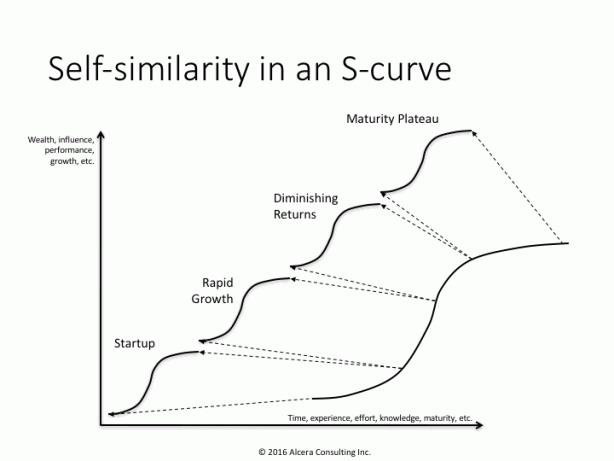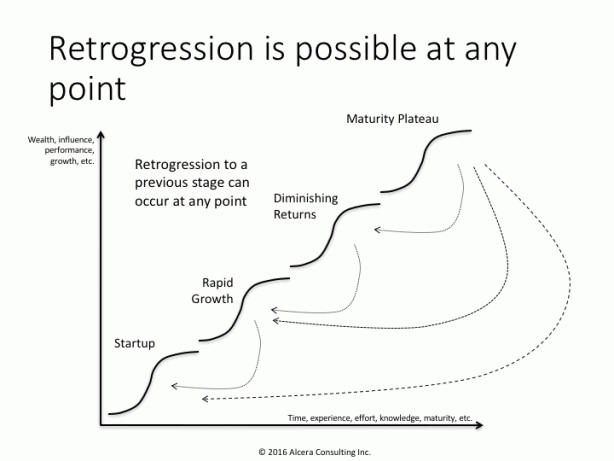Wednesday, September 28, 2016
Last week I introduced the concept of self-similarity and showed its relevance for power law distributions. In this post I discuss the applicability of self-similarity in S-curves.
To recap briefly, self-similarity implies that a structure looks essentially the same at all levels of “magnification” or scale. You can zoom in on any part of a “power curve,” and it will look like… a power curve, with basically the same appearance as at the higher scale.
The same phenomenon can be seen in s-curves, with the difference that the scale invariance is less apparent, at least initially. The following diagram shows how each phase on an s-curve can be broken out into smaller, constituent s-curves at the next lower level. By extension, each of these subordinate s-curves can be parsed in the same, self-similar way. The structure is recursive and nested. If you want to grow, develop, or improve in any way, you must see it as a succession of s-curves at all levels of scale.

This is why I’ve titled this post “Growth is a stairway, not a high jump!”. You make progress in increments, climbing from one step to the next in a succession of achievable bounds. This breaks progress and improvement into (to paraphrase Neil Armstrong) a series of “one small step” moves so you can make “one giant leap” for your bigger purpose… or goals.
This is more manageable from a psychological standpoint as well as logistically. It also makes risk more manageable. As I illustrate in the following diagram, there are risks at each transition to a succeeding s-curve. Risk can arise from making a jump–even a small one–to a higher level of performance and engagement. It can also arise from a drop in performance at this critical juncture. We can seldom know and do everything that is needed at the new level. We need to learn–which is why progress is depicted as an s-curve in the first place. We start out with low performance at the new level and a high potential for mistakes. If we’re focused on learning from our mistakes and on improvement, we get progressively better until we hit the rapid growth stage, and continue up the “learning” curve from there on in. When we hit the inevitable plateau, we must jump–or drop–to the next curve.

The final point is that performance or growth can bog down or slip at any point, for any number of reasons. We can stop or slip back down the curve we’re already on. I call this regression. Even more consequential is when we drop back to a previous curve. I call this retrogression, and I’ve illustrated it in detail in the following diagram. It shows how you can fall from any performance level to any other, usually through neglect, over-confidence, smugness, or simply through inattention to changing conditions in the environment. For instance, new technology, new competitors, changing demographics, all these can make our current success or standing shaky or even irrelevant.

I don’t say this to be overly pessimistic, but rather realistic. Stasis is death. Movement is crucial. Business, life, performance, everything, they are what is called a “red queen” race. You have to work just to stay in place and work even harder to make progress, grow, develop, get better.
We’ll address these issues and many more in my coming posts under the topic of “Ideas,” so stay tuned to this space.
My name is Richard Martin and, as indicated by the title of this blog, I’m an expert on applying readiness principles to position companies and leaders to grow and thrive by shaping and exploiting change and opportunity, instead of just passively succumbing to uncertainty and risk.
© 2016 Alcera Consulting Inc. This article may be used for non-commercial use with proper attribution.
Like this:
Like Loading...
Related
Let's block ads! (Why?)